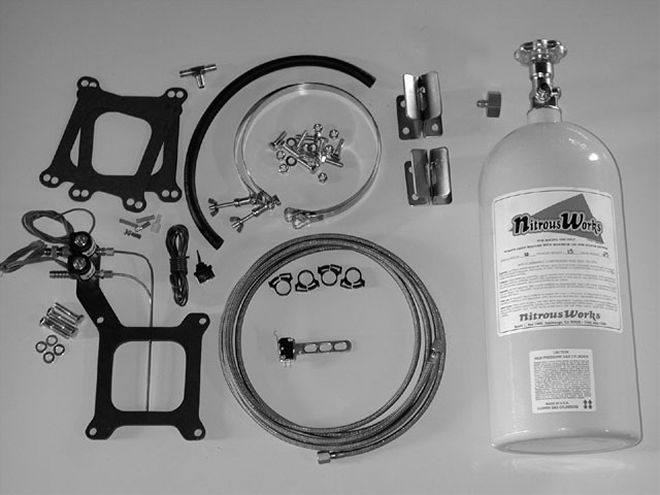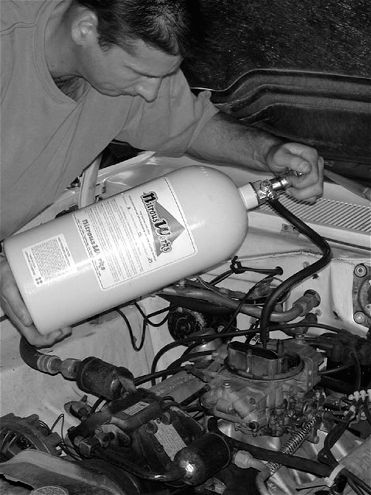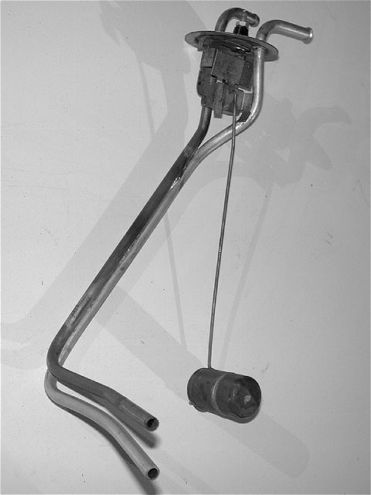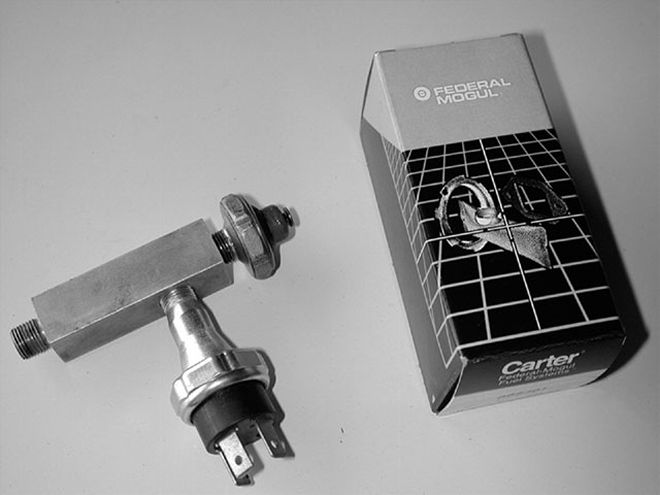
 A 125hp Nitrous Works kit was ordered for our 318 Dart driver to provide some chemical power enhancement. The kit provides everything needed, although we upgraded our installation with a few extras in the name of reliable long-term service.
A 125hp Nitrous Works kit was ordered for our 318 Dart driver to provide some chemical power enhancement. The kit provides everything needed, although we upgraded our installation with a few extras in the name of reliable long-term service.
Juice. Squeeze. "Nawz." Whatever you want to call it, there's no denying that nitrous oxide is synonymous with power. We work hard to get our engines to pull more air. Manifolds, ported heads, big cams, tuned headers, fat blocks with mega cubes, sky-high rpm-the whole freakin' show is about getting more air into the engine to support more fuel burning, to make more horsepower. Air takes up quite a bit of volume at atmospheric pressure, and getting more of it involved in the combustion process takes more cubes, more rpm, or greater efficiency moving in and out with the cubes you've got. Distill it down and that's all there is. There are limits to rpm and how efficiently the engine sucks in air, uses it up, and spits it out. This is the volumetric efficiency of the engine, and 100 percent is doing good.
Scienced-out race engines with tuned intakes, exhausts, and cams can exceed 100 percent in a narrow range of rpm, but ultimately there is only so far it can go with just atmospheric pressure and the engine's displacement providing the pull. This translates to limits on power production-not in horsepower, which can keep going up with rpm-but with torque output per cube. A really good street engine can touch 1.25 lb-ft per cubic inch, and an exceptional one may get in the 1.3 range. Race engines don't see much more.
 Drink-up, little 318, and you will grow up to be a big boy.
Drink-up, little 318, and you will grow up to be a big boy.
Want more? It will take more air. With supercharging, either by a crank-driven blower or a turbo, we can get more air in the engine. This ups the torque-per-cube output, which equals more horsepower. Nitrous does the same thing, but instead of adding more air, oxygen-rich nitrous oxide is injected to support the combustion process. Nitrous, truly, is liquid horsepower with the ability to boost torque to the limits of an engine's ability.
Nitrous contains 36 percent oxygen by weight, with nitrogen as the other component of the chemical compound. Under the heat of combustion at 572 degrees fahrenheit, the compound separates, releasing oxygen that supports burning more fuel, thus making extra power. The nitrogen component stabilizes the process. Modern nitrous systems consist of two circuits: one injects extra fuel, which actually makes the BTUs that produce the power, and the other is the all-important nitrous oxide, there to support the burning of that extra fuel. With solenoids controlling the injection of the added fuel and nitrous, more power is literally the flip of a switch away.
Unlike a normally aspirated engine, the output per cube with nitrous isn't limited by the efficiency and displacement of the engine. Big-block torque numbers (or more) across the entire rpm range are no problem with squeeze and, by definition, that added torque is added horsepower.
Unlike a conventional supercharger that creates heat when building boost, nitrous creates a cooler temperature. The nitrous is stored under high pressure as a liquefied gas. Once released into the intake manifold or port, the liquid nitrous changes to a gas form. As you physicists know, the rules of the latent heat of vaporization dictate that heat energy is absorbed from the surroundings in the process. For the rest of us it just means that injecting nitrous cools the intake charge, making a denser, more powerful mixture.
 We pulled the fuel-gauge sending unit out of the tank and fabricated a second pickup tube, which we soldered in place next to the stock one. Our completed pickup gives the nitrous fuel enrichment its own circuit separate from the engine's main fuel system.
We pulled the fuel-gauge sending unit out of the tank and fabricated a second pickup tube, which we soldered in place next to the stock one. Our completed pickup gives the nitrous fuel enrichment its own circuit separate from the engine's main fuel system.
Nitrous oxide is a remarkable compound for adding power, but is it all sunshine? Two things can't be ignored-the mixture ratio and the physical power-handling limits of the engine. The nitrous-to-fuel ratio is a critical part of a system's design. Nitrous oxide isn't picky about what it consumes. If there isn't enough gasoline in the mix it will eat plugs, pistons, and valves. While a lean condition causes major engine damage, running rich certainly won't cause catastrophic engine failure. Actually (to a point), a rich condition is beneficial, helping suppress detonation and reduce peak combustion temperatures. How well the mixture is dialed in is ultimately a matter of how well the nitrous kit manufacturer calibrated the system. The most important thing to remember is to follow the manufacturer's recommendations for fuel pressure. Staying out of trouble also means being realistic about the power-handling capabilities of the base engine. There's huge power to be had with nitrous, but, sorry buddy, a 300hp shot will scatter your stock 318 before you leave the water box.
Speaking of stock 318s, we had a stock bottom-end 318 in our Dart. With ported Edelbrock heads, a 750 carb on Edelbrock's RPM intake, TTI headers, and a Comp Cams XE268 hydraulic cam, it really hauls for a little 318. While the output was more than respectable, getting even more out of it would have come at the cost of drivability. With just a little squeeze, things could become pretty interesting without compromising the daily utility of the car. We ordered a 125hp plate system from The Nitrous Works to give us an ace in the hole should the need arise. The 125-horse kit is considered a smaller system, but we figured it would be a safe level with our engine package.
 To prevent the possibility of hitting the nitrous with the engine off, and to meet sanctioning body rules for cutting out the fuel pump if the engine dies, we got an oil pressure switch from Carter. The "T" block is an original Mopar piece from a cop car, so we retained the stock oil-light switch.
To prevent the possibility of hitting the nitrous with the engine off, and to meet sanctioning body rules for cutting out the fuel pump if the engine dies, we got an oil pressure switch from Carter. The "T" block is an original Mopar piece from a cop car, so we retained the stock oil-light switch.
We installed the system, perhaps going overkill with the fuel-system mods, but we wanted a dedicated fuel system to eliminate the possibility of engine lean-out. The solenoids were wired through a heavy-duty relay, which also fires an auxiliary electric fuel pump armed by a toggle switch mounted inside the car. The installation was fairly simple, just a matter of mounting the plate under the carb and the bottle in the trunk, routing the lines, mounting the switches, and wiring it all up. As is required with nitrous, we dialed some timing out of the ignition, cranked the bottle open, and hit the road.
We had the system rigged to a microswitch activated at wide-open throttle. Cruising along in Second gear at about 3,500 rpm, we slowly rolled into the throttle. As WOT was reached, the nitrous switch tripped, and wham, it was like getting hit in the rear by a freight train. The surge of low-end torque was like a stout big-block, and it kept pulling cleanly to our 6,500 rpm redline. We banged Third, and the freeway-geared Dart was at a dangerous speed in a flash.
That 125 extra horsepower provided a bigger blast of power than we expected. We were hooked. On the juice, our hot little 318 became an animal on steroids, with a rush so addictive we could hardly keep out of it. We were bitten, the monkey was on our back, and there's no rehab in sight-just us lurking the streets waiting for our next fix of nitrous-enhanced motoring.